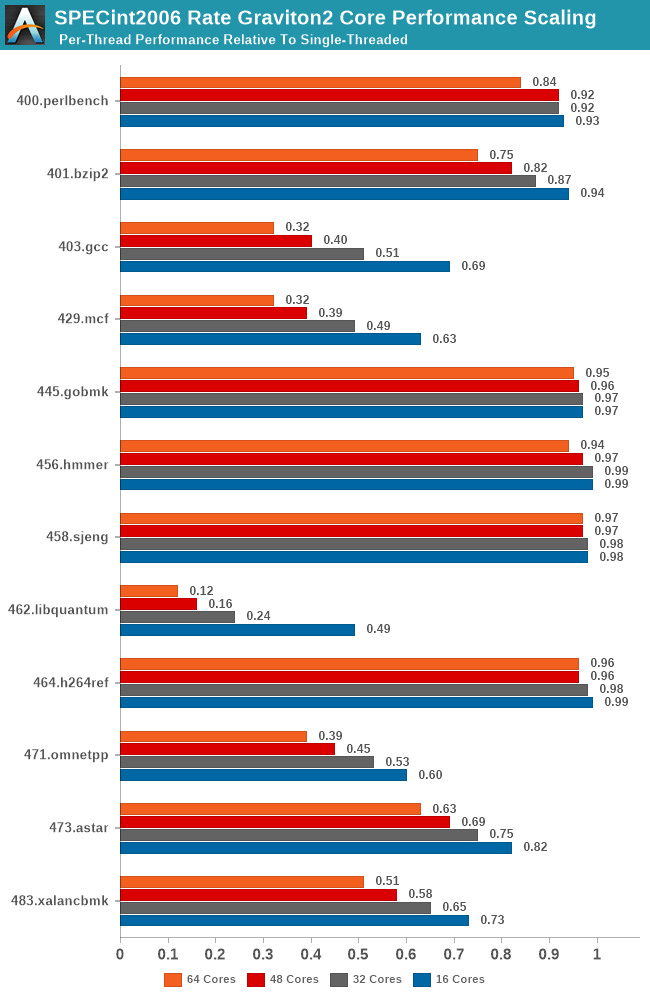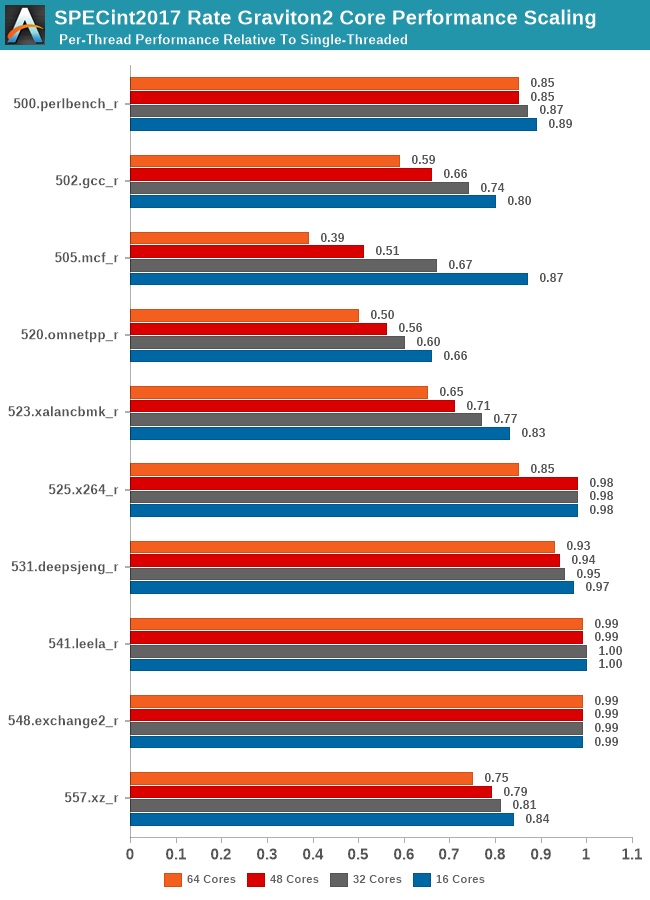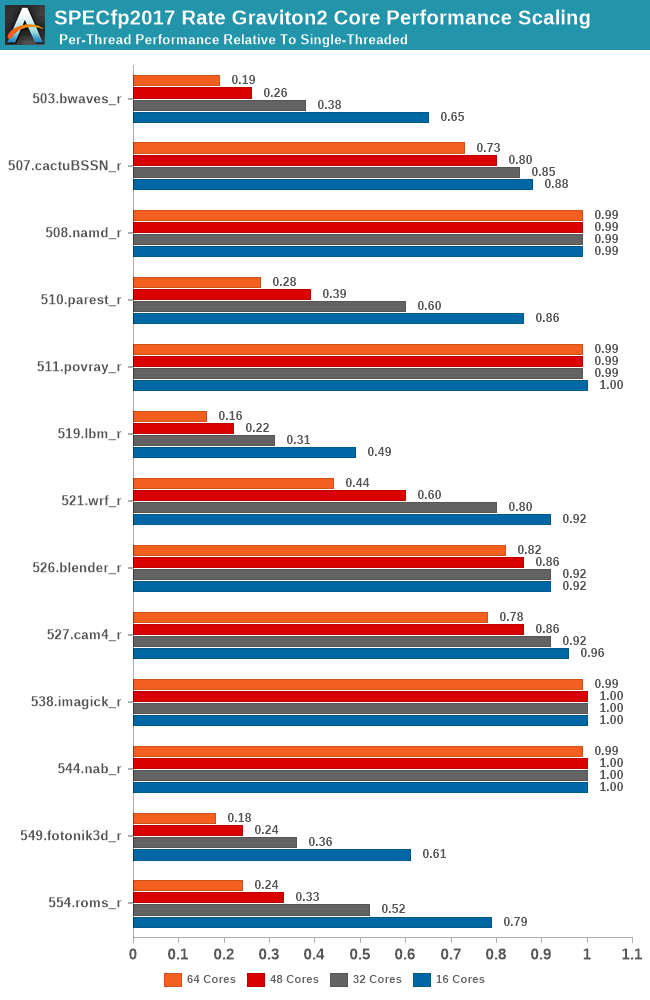Amazon's Arm-based Graviton2 Against AMD and Intel: Comparing Cloud Compute
by Andrei Frumusanu on March 10, 2020 8:30 AM EST- Posted in
- Servers
- CPUs
- Cloud Computing
- Amazon
- AWS
- Neoverse N1
- Graviton2
SPEC - Multi-Core Performance Scaling
I did mention the L3 cache of the Graviton2 was shared amongst all its cores, and we also discovered how only 8-16 cores were able to saturate the memory controllers of the system. To put those aspects into better context, I ran the SPEC suites at rate instance numbers, ranging from 16, 32, 48 and the full 64 cores, and normalised the results relative to the per-thread performance showcased in the rate-1 single-threaded runs.
What this attempts to showcase is the performance scaling of the full SoC across varying loads of the different workload types. Scaling linearly across cores might be easy for some workloads, but for anything that even remotely has some kind of memory pressure should see greater slowdowns given that all the threads are competing for the shared L3 and DRAM resources.
The testing here for all figures were done on a 16xlarge instance with 64 vCPUs to avoid the possibility of noisy neighbours, and give better reliability in the lower core count results.

As expected, we’re seeing a quite wide range of results here, and it’s also a good showcase of which SPEC workloads are memory and cache intensive and which are not. Workloads such as 445.gobmk and 456.hmmer aren’t surprising in their near linear scaling as they don’t have too much cache pressure, and the Graviton2’s 1MB L2 per core is also more than enough for 464.h264ref.
On the other hand, well known memory intensive workloads such as 462.libquantum absolutely crater in terms of per-thread performance. This memory bandwidth demanding workload is fully saturating the bandwidth of the system early on with very few cores, meaning that performance barely increases the more threads and cores we throw at it. Such a scaling more or less is mimicked in other workloads of varying cache and memory pressure.
The most worrying result though is 403.gcc. Code compilation should have been one of the bigger use-cases for a platform such as Graviton2, but the platform is having issues scaling well with core count, undoubtedly a result of higher cache pressure of the system. In a single-thread scenario in the system a core would have access to 33MB L2+L3, but when having 64 cores doing the same thing at once you’d end up with only 1.5MB per core, assuming things are evenly competitively shared.

In SPECfp2006, again, we see the well-known memory intensive workloads such as 433.milc and 470.lbm crater in their per-thread performance the more threads you throw at the system, while other workloads are able to scale near linearly with cores.

In SPECint2017, we see the workload changes I referred to previously on the single-threaded page. The new gcc and mcf tests are actually scaling better than their 2006 counterparts due to actually reduced memory pressure on the new tests. It does beg the question of which variant of the test is actually more representative of most workloads of these types.

Compared to the int2017 suite, the fp2017 suite scales significantly worse for a larger number of workloads. When Ampere last week talked about its Altra processor, and that it was “designed for integer workloads”, that didn't make too much sense other than in the context that the N1 cores are missing wider SIMD execution units. What does make sense though is that the floating-point suite of SPEC is a lot more memory intensive and SoCs like the Graviton2 don’t fare as well at higher loaded core-counts.
It will be interesting to see where the Arm chip designers are heading to in regards to this general memory bottleneck. If your workload isn’t too memory intensive then scaling up to such huge core counts is an easy way to scale performance as well. On the opposite end of the spectrum on memory hungry workloads, these chips will just be memory starved. Arm had envisioned 64 core Neoverse N1 systems to have 64-128MB of L3 cache, and the CMN-600 scales up to 256MB total in a 128-core system, which seem like more sensible and balanced targets.










96 Comments
View All Comments
Wilco1 - Friday, March 13, 2020 - link
Developing a chip based on a standard Arm core is much cheaper. Arm chip volumes are much higher than Intel and AMD, the costs are spread out over billions of chips.ksec - Tuesday, March 10, 2020 - link
ARM's licensing comparatively speaking is extremely cheap even for their most expensive N1 Core Blueprint. The development and production cost are largely on ARM's because of the platform model. So Amazon is only really paying for the cost to Fab with TSMC, I would be surprised if those chip cost more than $300. Which is at least a few thousand less than Intel or even AMD.Amazon will have to paid for all the software cost though. Making sure all their tools, and software runs on ARM. That is very expensive in engineering cost, but paid off in long term.
extide - Friday, March 13, 2020 - link
Actual production cost is going to be more like $50 or so. WAY less than $300.ksec - Monday, March 30, 2020 - link
Only the Wafer Cost alone would be $50+ assuming 100% yield. That is excluding licensing and additional R&D. At their volume I would not be surprised it stack up to $300FunBunny2 - Tuesday, March 10, 2020 - link
"Vertical integration is powerful."I find it amusing that compute folks are reinventing the wheel from Henry Ford!! River Rouge.
mrvco - Tuesday, March 10, 2020 - link
It would be interesting to see how the AWS instances compare to performance-competitive Azure instances on a value basis.kliend - Tuesday, March 10, 2020 - link
Anecdotally, Yes. Amazon is always trying to bring in users for little/no immediate profit.skaurus - Tuesday, March 10, 2020 - link
At scale, predictability is more important in infrastructure than cost. It may seem that if we have everything we need compiled for Arm, we can just switch over. But these things often look easier in theory than practice. I'd be wary to move existing service to Arm instances, or even starting a new one when I just want to iterate fast and just be sure that underlying level doesn't have any new surprises.It will be fine If I have time to experiment, or later, when the dust settles. Right now, I doubt that switching over to these instances once they are available, is actually easy or even smart decision.
FunBunny2 - Tuesday, March 10, 2020 - link
"It may seem that if we have everything we need compiled for Arm, we can just switch over. But these things often look easier in theory than practice. "with language compliant compilers, I don't buy that argument. it can certainly be true that RISC-ier processors yield larger binaries and slower performance, but real application failure has to be due to OS mismatches. C is the universal assembler.
mm0zct - Wednesday, March 11, 2020 - link
Beware that in C struct packing is ABI dependent, if you write out a struct to disk on x86_64, and try and read it back in on Aarch64, you might have a bad time unless you use the packed pragma and use specified-width types. This is the sort of thing that might get you if you try to migrate between architectures.Also many languages (including C) have hand optimised math libraries with inline assembler, which might still be using plain-C fallbacks on other architectures. There was a good article discussing the migration to Aarch64 at Cloudflare, they particulary encountered issues with go not being optimised on Aarch64 yet https://blog.cloudflare.com/arm-takes-wing/